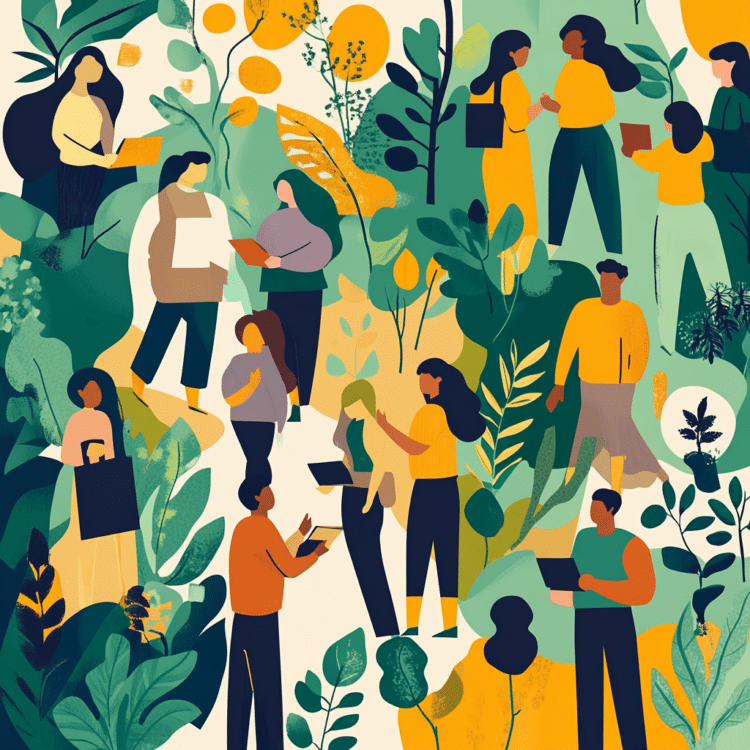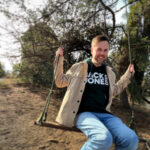
Collaboration and teamwork are the threads that knit together a sense of belonging and identity in a world that can feel increasingly isolating. Connecting with others can alleviate anxiety, foster growth, and help us tap into our collective potential. This article explores the psychology of human connection, focusing on emotional traumas, limiting beliefs, and social consciousness. We will discuss how depression, anxiety, and even neurodivergent perspectives such as ADHD can shape our interactions. Along the way, you’ll find journaling prompts to help you explore your own experiences and discover how building genuine, joyful relationships can lead to healing and personal growth.
Collaboration and Community-Driven Action
Collaboration is a powerful process that occurs when people come together to share ideas, resources, and energy to achieve a common goal. In a collaborative setting, each individual brings unique strengths that can help the entire group thrive. Community-driven action takes this a step further, uniting people around shared values or causes, such as environmental protection, social justice, or local neighborhood improvements.
Forms of Collaboration
- Team-Based Projects: Small groups working on a defined objective, such as designing a product or planning an event.
- Community Initiatives: Volunteer groups or non-profits that focus on a specific need, like community clean-ups or fundraising campaigns.
- Creative Collaborations: Artists, writers, and thinkers joining forces to produce something unique—anything from a community mural to an anthology of stories.
By participating in various forms of collaboration, we learn empathy, respect, and emotional intelligence—key foundations for healthy relationships.
Emotional Traumas, Limiting Beliefs, and Social Barriers
Many people hesitate to join groups or rely on others due to past traumas, pain, or self-doubt. Limiting beliefs—such as “I’m not good enough” or “I don’t fit in”—can keep us from embracing support and community.
How Trauma Impacts Relationships
- Fear of Rejection: Traumatic experiences may make us overly cautious, fearing abandonment or judgment.
- Low Self-Worth: Negative beliefs formed in childhood or past relationships can hinder our confidence.
- Emotional Withdrawal: We might shut down to protect ourselves from further hurt, leading to isolation.
Journaling Prompt
Think of a time you felt uncertain about your place in a group. What were the underlying beliefs you held about yourself? How might these beliefs be limiting you today?
Social Consciousness in the Brain
Humans have a natural tendency to seek connection because our brains are wired for community. We rely on shared resources, ideas, and emotional support to survive and thrive. The concept of social consciousness refers to our awareness of others’ feelings, thoughts, and situations. It’s the empathy that prompts us to step up, offer a shoulder to lean on, or support someone through adversity.
Lieberman, M. D. (2013). Social: Why Our Brains Are Wired to Connect. Crown Publishing Group.
Depression, Anxiety, and the Need to Withdraw
Depression and anxiety often bring on an urge to isolate. When someone is wrestling with these conditions, engaging with a group can feel overwhelming or exhausting.
- Depression: Can create a cycle of negative thinking and low energy, making any social interaction feel burdensome.
- Anxiety: Can cause constant worry about how one is perceived, triggering a fear response that leads to withdrawal.
Ironically, isolation exacerbates these symptoms by depriving the brain of the social connection it needs to heal.
Journaling Prompt
Reflect on a situation where you felt anxious or depressed. How did you handle social situations at that time? Is there a small step you could take toward connection if you face a similar situation now?
Why We Need Other People to Heal
Close, supportive relationships have profound effects on mental and emotional well-being. They can offer perspective, comfort, and a reminder that you’re not alone in whatever challenges you face. By sharing thoughts and emotions with others—whether in therapy groups, informal gatherings, or online communities—you gain a sense of safety that fosters healing.
The Role of Connection in Recovery
- Validation: Others can help normalize your experiences, reducing self-blame and shame.
- Encouragement: Kind words and positive feedback can boost motivation to keep going.
- Shared Experience: Hearing from others who have overcome similar struggles can empower you to believe in your own capacity to heal.
Good Conversations and Working Well Together
Building healthy teamwork and community starts with effective communication. Here are some strategies for engaging in meaningful dialogue:
- Listen Actively: Let the other person finish their thought without interruption, and respond to what they said rather than what you think they meant.
- Ask Open-Ended Questions: This invites deeper discussion and shows genuine interest.
- Practice Empathy: Try to understand the emotions behind someone’s words.
- Offer Constructive Feedback: When done kindly and honestly, it fosters trust and improvement.
- Celebrate Successes: Recognize and thank people for their contributions.
ADHD and Social Interaction
People with ADHD often experience social situations differently. They may struggle with attention, impulse control, or hyperfocus. In team settings, this can lead to misunderstandings or friction if there isn’t awareness and support.
- Overstimulation: Busy environments can be overwhelming, making it difficult to follow or participate in conversations.
- Impatience or Impulsivity: Interrupting or switching topics abruptly can alienate others if it’s not understood as part of ADHD traits.
- Strengths: Creativity, passion, and spontaneity can be great assets in group settings.
https://www.healthline.com/health/adhd/adhd-social-skills
Journaling Prompt
If you identify with ADHD or have similar traits, note how you feel in various social situations. What strategies (such as focusing techniques or self-reminders to pause before speaking) could help you engage more comfortably?
Becoming an Authentic Person in Social Environments
Authenticity involves aligning your words, actions, and values, even in group settings. At its core, it means allowing yourself to be seen—flaws and all—while extending the same courtesy to others.
Abstract Approach
- Know Your Values: Identify what matters most to you.
- Practice Self-Reflection: Regularly assess your thoughts and feelings to ensure they match your actions.
- Embrace Vulnerability: True connection requires a willingness to share parts of yourself that feel raw or imperfect.
- Listen With Compassion: When you respect others’ authenticity, you create a space for mutual understanding.
Concrete Example (At a Social Event)
Imagine you’re attending a networking event:
- Set an Intention: Before walking in, decide you want to truly connect, not just collect business cards.
- Listen and Ask: If someone discusses their passion, show genuine curiosity.
- Share Openly: When it’s your turn to speak, talk about your aspirations or challenges. It’s okay to admit you’re nervous or new to the environment.
- Offer Support: If you see someone struggling, offer a kind word or introduction to another guest who might share their interests.
- Reflect After: Consider how being yourself felt. Did you make any connections that resonated with you?
The Call to Action: Why We Need More Relationships Today
Modern life often promotes competition and individualism, yet our well-being hinges on cooperation and collective effort. Growing research shows that strong social networks improve resilience, health, and happiness. The excitement of connecting with another person—of being seen, heard, and valued—is unparalleled. Conversely, feeling disconnected can lead to hopelessness, deepening emotional struggles.
Improving the World Through Connection
When communities function like a global human brain, we pool knowledge, empathy, and problem-solving skills. Working together:
- Address Climate Change: Global collaboration speeds up innovation in clean energy, conservation, and sustainable living.
- Resolve Conflicts: Shared understanding and open dialogue can reduce tensions and foster peace.
- Advance Science and Exploration: Collective resources and knowledge enable breakthroughs in technology and space exploration.
By actively participating in social collaboration—whether in your neighborhood, online communities, or international coalitions—you can experience a profound sense of purpose and shared humanity.
Maslow’s Hierarchy of Needs
In Abraham Maslow’s model, social needs—love, belonging, and connection—sit right above our fundamental requirements for safety and physiological survival. This underscores the reality that humans don’t just want connection; we need it for psychological health. Our friendships, family ties, and community bonds make our lives meaningful and fulfilling.
Final Thoughts and Next Steps
We are social beings. When we collaborate and share, we can overcome personal challenges and tackle global problems. Each conversation, every community gathering, and each supportive gesture we exchange lights a spark in the “global human brain.” By strengthening our social fabric, we cultivate belonging, hope, and possibility for ourselves and the world.
Journaling Prompt
Who are the three people or groups you most want to connect with right now? How might these relationships help you grow, heal, or contribute to a bigger cause?
A Hypothesis to Consider
Hypothesis: Actively engaging in relationships—through supportive conversations, authentic self-expression, and collaborative projects—increases individual well-being and contributes to large-scale problem-solving.
Testing the Hypothesis
- Self-Check: Notice how you feel after spending quality time with others or contributing to a community project.
- Observation: Look for evidence of increased motivation or satisfaction in your daily life.
- Feedback Loop: Ask the people around you if they’ve noticed changes in your mood or energy when you’re more connected.
Follow-Up Questions
- How can we make collaboration more accessible to those who struggle with social anxiety or lack opportunities?
- In what ways can online communities fill gaps in physical connection, and what are their limitations?
- How can workplaces and schools better incorporate inclusive teamwork and community practices?

